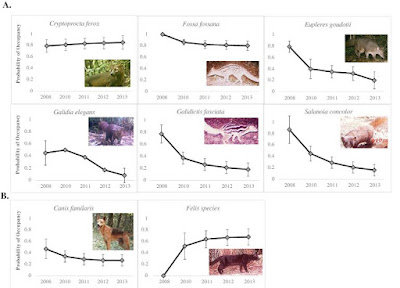Farris, Z. J., Kelly, M. J., Karpanty, S., Murphy, A., Ratelolahy, F., Andrianjakarivelo, V., & Holmes, C. (2016). The times they are a changin': Multi-year surveys reveal exotics replace native carnivores at a Madagascar rainforest site. Biological Conservation.
Surveys across multiple seasons or years are necessary to evaluate the effects of dynamic processes on long-term persistence of wildlife populations, such as effects of exotic species on native species populations. Unfortunately, multi-year surveys are rare, particularly for rainforest carnivore populations, and managers often rely on single-season/year, ‘snapshot’ surveys that produce static estimates of population parameters. Here we provide results using single-species, multi-year occupancy modeling from a six-year survey (2008–2013) of a rainforest carnivore community at a 15 km2 area study site within the newly established Makira Natural Park, Madagascar. We demonstrate a precipitous decline in the native carnivore community with four of the six native carnivores (falanouc Eupleres goudotii, ring-tailed vontsira Galidia elegans, broad-striped vontsira Galidictis fasciata, and brown-tailed vontsira Salanoia concolor) decreasing by at least 60% over this six-year period. In addition, we observed two exotic carnivores (small Indian civet Viverricula indica and feral cat Felis species) colonize this study site with Felis species increasing in occupancy from 0 to 0.68 by the final year. Further, we demonstrate how variables associated with human encroachment (i.e. distance to forest edge and nearest village) are most important for explaining these trends in native carnivore extirpation and exotic carnivore colonization. These findings provide additional evidence on the threat posed to native carnivore populations by the expansion of exotic carnivores worldwide. We highlight the striking increase in extirpation, and the factors influencing such changes, for native carnivores. In this manuscript, we point to the limited number of multi-year surveys to evaluate dynamic processes on long-term persistence of native wildlife populations, as well as the lack of exotic carnivore control programs in threatened ecosystems in many developing nations as factors limiting our ability to effectively conserve biodiversity across the globe.
Surveys across multiple seasons or years are necessary to evaluate the effects of dynamic processes on long-term persistence of wildlife populations, such as effects of exotic species on native species populations. Unfortunately, multi-year surveys are rare, particularly for rainforest carnivore populations, and managers often rely on single-season/year, ‘snapshot’ surveys that produce static estimates of population parameters. Here we provide results using single-species, multi-year occupancy modeling from a six-year survey (2008–2013) of a rainforest carnivore community at a 15 km2 area study site within the newly established Makira Natural Park, Madagascar. We demonstrate a precipitous decline in the native carnivore community with four of the six native carnivores (falanouc Eupleres goudotii, ring-tailed vontsira Galidia elegans, broad-striped vontsira Galidictis fasciata, and brown-tailed vontsira Salanoia concolor) decreasing by at least 60% over this six-year period. In addition, we observed two exotic carnivores (small Indian civet Viverricula indica and feral cat Felis species) colonize this study site with Felis species increasing in occupancy from 0 to 0.68 by the final year. Further, we demonstrate how variables associated with human encroachment (i.e. distance to forest edge and nearest village) are most important for explaining these trends in native carnivore extirpation and exotic carnivore colonization. These findings provide additional evidence on the threat posed to native carnivore populations by the expansion of exotic carnivores worldwide. We highlight the striking increase in extirpation, and the factors influencing such changes, for native carnivores. In this manuscript, we point to the limited number of multi-year surveys to evaluate dynamic processes on long-term persistence of native wildlife populations, as well as the lack of exotic carnivore control programs in threatened ecosystems in many developing nations as factors limiting our ability to effectively conserve biodiversity across the globe.

No comments:
Post a Comment